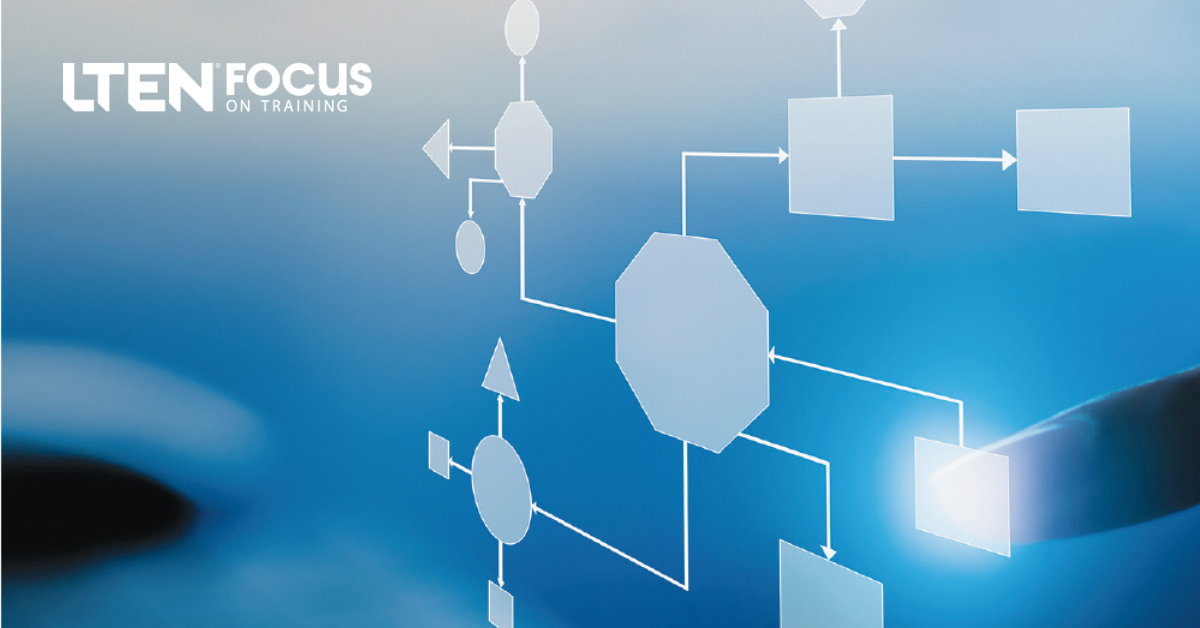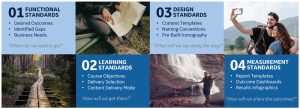
Cover Story – By Kevin Clemence
Streamlining can help trainers overcome daily challenges
 Standards play an integral role in our daily lives. Through their adoption, we have created a safer, more predictable world. From traffic signs that govern our commutes to protocols that enable device connectivity, standardization continues to enhance society.
Standards play an integral role in our daily lives. Through their adoption, we have created a safer, more predictable world. From traffic signs that govern our commutes to protocols that enable device connectivity, standardization continues to enhance society.
Beyond safety and communication, process standardization continues to drive productivity across business. From Henry Ford’s assembly line to Toyota and Motorola’s introduction of “Lean” and “Six Sigma” principles, industry leaders continue to seek out ways to streamline their processes.
As it turns out, learning & development (L&D) as a business function is no different. To overcome day-to-day challenges such as resource constraints and unique stakeholder requests, introducing elements of repeatability allows professionals to deliver on time and with excellence.
Our entire design cycle is loaded with opportunities to introduce standard process elements. The challenge for L&D is balancing the rigidity of such guardrails with the fluidity of creative problem-solving and inspired design.
This article aims to explore the concept of process standardization as it can be applied throughout L&D. We’ll look at categorizing program elements and assessing overall competency in each area. Beyond this, we’ll consider multiple standard options.
First though, let’s agree on the overall concept definition.
Defining Standardization
When examining a program for improvement opportunity, it helps to be grounded in the concept of standardization. There are many definitions out there to choose from, and many contain common elements. These include “a model or pattern used for guidance” as well as “something set up by authority or by general consent.” Other elements commonly found include “a level of quality,” “a basis for comparison” or “an acceptable benchmark, criterion or guideline.”
For our purposes here, let’s consider “a framework of benchmarked expectations for the design, development, launch, measurement and ongoing continuous improvement of learning elements that help ensure consistency and coherence for our learners.”
This definition rightly identifies the learner as the primary benefactor of our standardization efforts. It also includes the key element of continuous improvement, meaning that no single standard is written in stone and all standards should be assessed overtime for enhancement opportunities.
Learning Standard Categories
A recommended first step when examining programmatic elements is to organize them into discernable categories. Without this, one might be tempted to dive right into designing elearning templates without first considering other aspects such as actionable learning objectives or even core business needs.
The four categories presented in Figure One are a solid starting point for analysis. From here, we can organize our efforts and examine how each categorical item builds upon the previous. As you review the categories, consider how just a single program standard could potentially enhance your team’s ability to reliably and repeatably deliver with excellence.
Competency
In some instances, one or more of these elements might be less familiar to you than others. That is all right! What is important is that you can recognize where your strengths and opportunities of improvement lie. L&D professionals are fortunate to have access to networks such as LTEN that offer countless opportunities to benchmark across the industry. Leverage this collective experience to find out who is strong where you are not.
Figure 2 is a quick reminder of the conscious competency model. Before you can enhance all elements of your local program, you first need to gain awareness across each category.
Briefly consider how strongly your existing department executes each element. Does it take considerable effort to identify basic business needs? Is your team able to facilitate content delivery at peak levels without even thinking about it? Have you ever considered applying effectiveness results to your next project?
For each of the following topics presented in this article you should consider where your organization lands across the four quadrants of Figure 2. If you identify yourself as either “Unconsciously” or “Consciously Incompetent” for any one topic, you are strongly encouraged to leverage the LTEN network to seek out lessons learned and best practices.
Exploring ‘Functional Standards’
Our first category up for consideration are “functional standards, which align closely with the analysis phase of the ADDIE development model. When kicking off a new instructional project, best practice dictates that we conduct a thorough needs analysis. This initial step allows for the identification of critical business, process owner and target audience needs.
To address the question “Where do we need to go?” more effectively and comprehensively, what if we made use of a standardized needs analysis questionnaire that includes a well-thought-out series of relevant inquiries? By introducing a required intake form, more thought can be directed toward the unique requirements of the project instead of brainstorming which questions to ask during a kickoff meeting.
Additionally, what if you standardized a process where key project stakeholders could reference the resulting intake form throughout the project’s lifecycle? Would there be value in all involved having access to this information later in your design cycle?
Underlying business needs remain a key driver of all actions taken by an L&D organization. Documenting and communicating these business needs in a standardized manner allows for focused alignment by everyone involved. Consider using a standardized slide template to communicate these needs during key recurring operating mechanisms.
Defining ‘Learning Standards’
The next category to consider includes “learning standards,” which help to determine how our desired destination will be reached. Here is where creative problem-solving first enters the equation, and where “analysis paralysis” is first likely to strike. L&D is exciting because there are many routes we can choose to take to our desired outcome. Consider implementing one or more of the following learning standards when selecting the best path forward.
The upfront establishment of learning objectives often provides an initial project vector. It is advisable to define objective format standards that are SMART-aligned(Specific, Measurable, Achievable, Relevant and Time-bound). For example, “being sufficient at SPIN selling” may be less effective than “learners will immediately be able to ask relevant sales questions across all four categories of the SPIN selling model.”
SMART objective standards also assist us in selecting a delivery mode for our content. If our objectives are heavily based in demonstration, we may begin considering instructor-led or virtual content delivery to allow for in-class demonstration exercises. At minimum, we may at least consider a quiz option for a knowledge transfer demonstration.
Organizations may even consider implementing a standard decision matrix for the selection of delivery format. Elements from the analysis phase could feed this flowchart and allow for consistency when choosing elearning vs. instructor-led delivery. Decision points may also be introduced that could weed out lesser instructional needs and recommend meeting coverage of the topic instead. This could help improve our collective bandwidth and address the resource constraint issue we all face.
Selecting ‘Design Standards’
Our third category up for consideration includes “design standards,” which are the primary drivers for the development of our end learner experience. If we intend to standardize elements of this phase, we will need to consider the delicate balance of rigorous structure and inspired design. If presented incorrectly, an instructional design team may feel unfairly restrained.
In all honesty, carefully selected design standards have the power to free your top creative talent to focus on the most impactful and creative design choices by shifting their focus away from lesser elements.
Your team should consider introducing a standard set of content template designs. Common program deliverables such as elearning modules, facilitator guides, job aids and reference materials can each have a standard starting template designed. So long as these templates comply with internal branding standards, your instructional designers no longer need to start each project with a blank sheet of paper.
Beyond these templates and based on the complexity of your business, a common set of designed iconographies is a great way to introduce repeatable visual elements throughout your content. A simply designed icon that depicts a specific product family or required learner action can visually streamline your materials. Added bonus: Visual icons do not require language translation!
One final recommendation in the design phase would be to consider adopting a standardized content identification process. A unique course ID could contain useful metadata that allows members of L&D to quickly locate materials. Additionally, a standard set of content tags within your learning management systems (LMS) or learning experience platform (LxP) can greatly aid your learners in locating your materials.
Choosing ‘Measurement Standards’
The fourth and final category to consider directly aligns with the “evaluation” stage of ADDIE and involves careful selection of “measurement standards.” High-producing L&D programs yield many megabytes of results data. Completion records, quiz results and collected learner feedback all have a story to tell. Robust L&D programs include feedback loops that allow these stories to directly influence continuous improvement.
Standards to consider here include report and dashboard templates, as well as pre-defined performance thresholds that determine success vs. failure. You may also wish to consider incorporating a standardized infographic template for visually representing your organization’s latest L&D accomplishments.
Microsoft Excel is a powerful tool and can be wielded to produce highly effective learning results dashboards that feed these standard infographics. With some basic instruction and practice, macros and formulas can be learned that transform raw system data exports into highly visual storytelling machines.
Our Challenge for You
Hopefully you have taken something away from this article. Working in L&D within the life sciences space is a privilege. Our efforts can positively impact the health, safety and overall wellbeing of patients and their families.
The adoption of L&D standards has the power to streamline our day-to-day processes and help to ensure consistent and reliable outcomes.
 Kevin Clemence is GE HealthCare’s learning leader of technology and metrics and was a 2023 LTEN Excellence Award finalist in the Practitioner Innovation category. Email Kevin at kevin.clemence@ge.com or connect via LinkedIn at www.linkedin.com/in/kclemence.
Kevin Clemence is GE HealthCare’s learning leader of technology and metrics and was a 2023 LTEN Excellence Award finalist in the Practitioner Innovation category. Email Kevin at kevin.clemence@ge.com or connect via LinkedIn at www.linkedin.com/in/kclemence.










